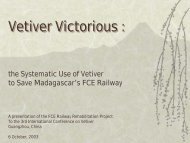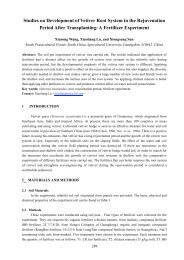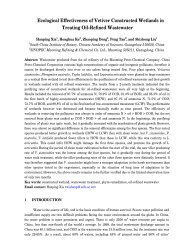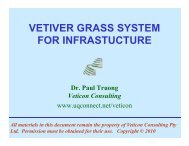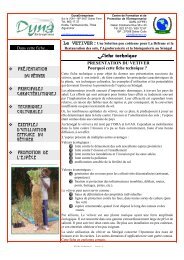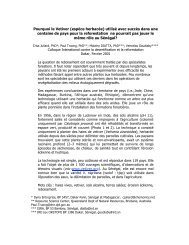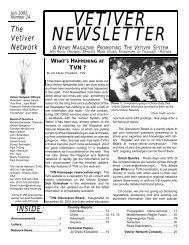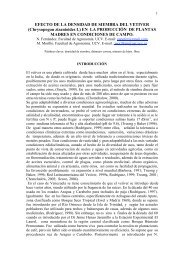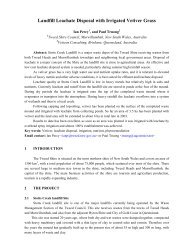Vetiver in Thailand: General Aspects and Basic Studies - The Vetiver ...
Vetiver in Thailand: General Aspects and Basic Studies - The Vetiver ...
Vetiver in Thailand: General Aspects and Basic Studies - The Vetiver ...
Create successful ePaper yourself
Turn your PDF publications into a flip-book with our unique Google optimized e-Paper software.
5Tissue culture technique has been used for veitver propagation as it canproduce large quantity of plantlets <strong>and</strong> it is convenient for transportation for plant<strong>in</strong>g<strong>in</strong> other places. In order to promote rapid multiplication, the Department of Botanyresearch team successfully developed this technique us<strong>in</strong>g lateral or term<strong>in</strong>al buds ofvetiver with a 70 % survival rate of plantlets. S<strong>in</strong>ce 2002, they have propagated <strong>and</strong>distributed more than 100,000 vetiver seedl<strong>in</strong>gs each year to various governmental<strong>and</strong> non-governmental organizations for the promotion of vetiver technology.With tissue culture technique, Na Nakorn et al. (2000) experimented to <strong>in</strong>ducesalt tolerance <strong>in</strong> n<strong>in</strong>e vetiver ecotypes. From the results, the 50-gray gamma irradiatedcalli of Kamphaeng Phet 1 ecotype exhibited maximum degree of salt tolerance. <strong>The</strong>calli could tolerate up to 4% NaCl, higher than those of without radiation at 3%NaCl. <strong>The</strong> plantlet regeneration of salt tolerant calli is the next goal of this researchteam.Plant cells resistant to herbicides have been produced by <strong>in</strong> vitro selection <strong>and</strong>successfully used <strong>in</strong> the study of herbicide resistant plant production. Prasertsongkunet al. (2002) performed an experiment to select vetiver cells suspension resistant toglufos<strong>in</strong>ate <strong>and</strong> <strong>in</strong>vestigated the mechanisms of resistance. <strong>The</strong>y could select vetivercells which were 170-fold resistant to glufos<strong>in</strong>ate, compared to the susceptible cells.<strong>The</strong> glutam<strong>in</strong>e synthetase (GS) activity of the resistant cells was twice as high as thatof the susceptible cells. <strong>The</strong>se results showed that the resistance of the selected vetivercell suspension to glufos<strong>in</strong>ate is ma<strong>in</strong>ly due to <strong>in</strong>creas<strong>in</strong>g GS activity <strong>and</strong> its decrease<strong>in</strong> sensitivity to the herbicide.<strong>Vetiver</strong> <strong>and</strong> soil fertility studySoil fertility, which is an important factor for agricultural productivity, is<strong>in</strong>fluenced by parent material <strong>and</strong> <strong>in</strong>appropriate soil management practices. Manyresearch works on soil fertility improvement by vetiver have been <strong>in</strong>vestigated. <strong>The</strong>experiment done by Roongtanakiat et al. (2000) revealed that vetiver mulch<strong>in</strong>gconserved topsoil moisture <strong>and</strong> <strong>in</strong>creased available-N, available-P <strong>and</strong> extractable-K.<strong>The</strong> further experiment showed that one tonne of dry vetiver shoot buried at the depthof 10 cm would yield m<strong>in</strong>eral N, available-K upto 4.4, 2.2 <strong>and</strong> 20.5 kg while that lefton the soil surface would yield only 0.85, 0.74 <strong>and</strong> 7.20 kg, respectively (Chairoj <strong>and</strong>Roongtanakiat, 2004).<strong>Vetiver</strong> cultivation could improve some chemical <strong>and</strong> physical properties ofsoil. Tantachasatid (2003) cultivated vetiver <strong>in</strong> laterite soil, Phon Phisai soil series.After n<strong>in</strong>e months, a certa<strong>in</strong> level of improvement of soil properties such as pH,organic matter, available-P, extractable-K, aggregate stability, bulk density,permeability <strong>and</strong> available water capacity, could be achieved by cultivation of vetiveras a sole crop <strong>and</strong> mixed cropp<strong>in</strong>g with cover crops.Soil microorganisms associated with vetiver are important for vetiver growth<strong>and</strong> development especially <strong>in</strong> <strong>in</strong>fertile soil. <strong>The</strong>y produce nutrient sources <strong>and</strong> <strong>in</strong>duceplant growth hormones for vetiver. Techap<strong>in</strong>yawat et al. (2000) reported that VAmycorrhiza <strong>in</strong>oculated to vetiver significantly <strong>in</strong>creased plant biomass <strong>and</strong> the nutrientuptake. With isotope tracer technique, Techap<strong>in</strong>yawat et al. (2002) studied the effectsof 3 species of arbuscular mycorrhizal fungi: Acaulospora scrobiculata, Glomus sp.,Glomus aggregatum <strong>in</strong> comb<strong>in</strong>ations with phosphate fertilizer on P-uptake of vetiver.




